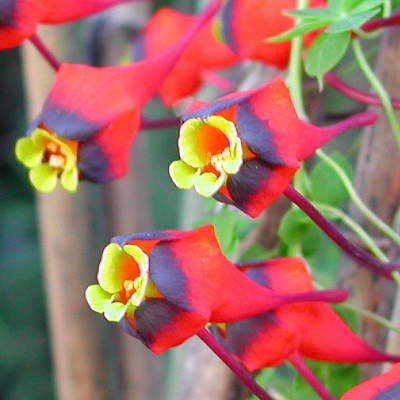"Chilean Nasturtium"
Germinating the seeds
These seeds sprout best when given a cold treatment first. The tips below explain the process. When to plant -- Plant your seeds when you receive them for best results Getting started -- Soak them in a cup of water for about 1 day (not more than 2 days). Use a pot about 3 inches (7-8 cm) tall, and wide enough so each seed is 1 inch (2.5 cm) from each other and the sides of the pot. Fill with a fast draining soil. A typical mix 1 part quality potting soil to 1 part coarse horticultural sand or perlite (use small- or -medium grade perlite, not large chunks). An alternate mix is 1 part coir fiber to 2 parts perlite or coarse sand. Don't add lime to the mix, unless using peat moss instead of coir fiber. Place the seeds on top, and cover with 1/4 inch (7 mm) of soil. Add water until the soil is evenly moist (but not fully saturated. Place the pot in a sealed container or plastic bag. Place in the refrigerator and mark your calendar to remove them in 6 weeks. After removing from the refrigerator,
place the pot in area that stays between 45-75 degrees F (7-24 Celsius) during the day, and
40-65 degrees F (5-18 Celsius) at night.
If your home is warm, try placing it on the floor of a cool room. I
recommend placing a
minimum/maximum thermometer The seeds normally sprout at different times. Most of them should sprout approximately 2-4 months after removing them from the refrigerator. Some of them may take longer. Once they sprout, give them bright light, such as morning sun, filtered sun, or fluorescent or LED lighting (See: "Growing indoors with LED lights"). Protect them from strong afternoon sun. Watering -- Keep the soil evenly moist (but not constantly saturated). Fertilizing -- When they are a week old, give a small amount of liquid fertilizer (about 1/8 strength), and repeat 2 weeks later. Hydroponic fertilizer is ideal for young seedlings, since it is easily absorbed and complete. After 3 months, you may switch to a general-purpose, granular fertilizer that contains micronutrients. Climate -- It prefers temperatures below 80 degrees (27°C) with nights that are cool (below 65°F / 18°C) and frost-free. It might not thrive in areas that regularly get above 80 degrees from fall through spring, especially if nights are warm. It is said to be able to handle a light, brief frost, but i recommend protecting it from freezing temperatures. It prefers part sun, with protection from strong afternoon sun. Over about 40% humidity is best. Support -- Give the shoots a vertical support to twine themselves around. You can use thin sticks like wood barbecue skewers. The support doesn't need to be tall the first year. The second or third year you may use a tomato cage or similar support. Dormancy -- The tubers normally go dormant in spring or summer, but it may happen at other times if growing them indoors under lights. If the leaves begin to turn yellow, the tuber may be preparing for dormancy, so reduce the watering to prevent rot. Once the shoots die back, dig up the tubers. If you find any seeds that didn't germinate, repeat the refrigeration process above - there is a good chance they will sprout. Tips on repotting the tubers are here. If any questions or problems come up, feel free to contact me. Have fun growing them! - Jeff Strange Wonderful Things
|
|||||||||


